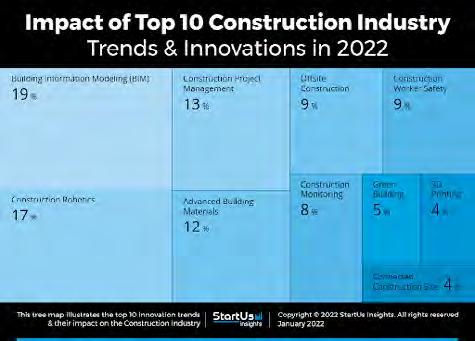3 minute read
What the Infrastructure Bill Means for Public Sector Construction
FEATURE
What the Infrastructure Bill Means for Public Sector Construction
by Sandra Benson, Procore
The more than $1 trillion infrastructure bill recently signed by President Biden is one of the most ambitious and largest upgrades of U.S. roads, highways and other transportation infrastructure in a generation. Billions will be poured into overhauling the nation’s public works system, mitigating climate change, and accelerating new projects with the hope of creating thousands of jobs.
Known as the Infrastructure Investment and Jobs Act, the bipartisan legislation offers a once-in-a-lifetime opportunity to jumpstart and champion critical projects. This gives organizations the financial ability to refocus their energy on larger and more strategic long-term projects and needs as opposed to long backlogs of stopgap repairs and upgrades.
Of course, big questions remain. Namely, what does the bill mean for the public sector and how can construction professionals at public organizations ensure they’re prepared?
Let’s break it down.
Public sector owners will be challenged to evolve in the way they manage their programs.
Federal agencies such as the Department of Transportation, the Department of Energy, and the Environmental Protection Agency will receive the majority of funding and be responsible for implementing the ambitious legislation, including the disbursement of funds. State and local officials, who own and operate the majority of infrastructure, will be responsible for designing and building the assets, hiring additional workers, and tracking the funding sources across projects.
The $1 trillion piece of legislation includes $110 billion for roads and bridges, $66 billion for Amtrak improvements and expansion, $65 billion for broadband internet expansion, $65 billion to rebuild the electric grid, as well as $55 billion to upgrade water systems including replacing lead pipes. This bill also includes billions for airports, sea ports, public transit and electric vehicle charging stations.
The $1 trillion bill also includes billions earmarked for airports, sea ports and public transit.
Public sector organizations who deliver these types of infrastructure projects should start planning now for the increase in capital funding and look for ways to manage and prioritize the influx of projects efficiently and transparently.
There is no doubt that public sector owners will be challenged to evolve in the way they track funds, control costs and deliver real-time status updates on projects and programs. As a result, organizations can no longer afford to be on the fence about investing in integrated digital solutions – the scale and visibility of these projects demand it.
Get ahead by investing in digital solutions now.
Covid-19 both underscored and accelerated the need for digital innovation within state and local municipalities as well as the larger public works ecosystem. While the American Rescue Plan provided funds to address some of these fundamental issues including investments in tech, the Infrastructure Bill goes further by allocating $100M over five years for digital construction management solutions.
This signifies a major effort by the federal government to ensure organizations are using infrastructure funds in the most efficient way possible. Public sector owners still using pen and paper or cobbled together legacy solutions will likely find it challenging to maximize efficiencies and standardize projects without an investment in digital transformation. Not only that, the risks associated with doing nothing are real.
According to a recent Procorecommissioned IDC survey, public sector owners leveraging integrated digital solutions were more likely to deliver projects on budget and on schedule while their low-performing counterparts were more likely to rely on manual processes or outdated productivity software to finish projects late and overbudget. This tells us that the relationship between efficiency and technology cannot be overlooked, especially when it comes to rebuilding the nation’s infrastructure.
There is no better time than now to invest in digital transformation. In fact, it may very well be an allowable expense or a prerequisite for funding. At the very least, it will improve the position of a given bid or proposal. When you combine consistency, standardization, and accountability with streaming data and automated processes, you ensure your public sector organization is able to maximize efficiencies for exceptional project delivery, making the best possible use of time and infrastructure dollars.
For more insight into infrastructure bill challenges and opportunities, check out this webcast where I discuss the infrastructure bill live with our partner Carahsoft.
About the Author
Sandra Benson is Procore's Global
Head of Industry Transformation. She has more than 25 years of experience in the building and construction technology industry, along with a deep knowledge of construction operations in various countries.








